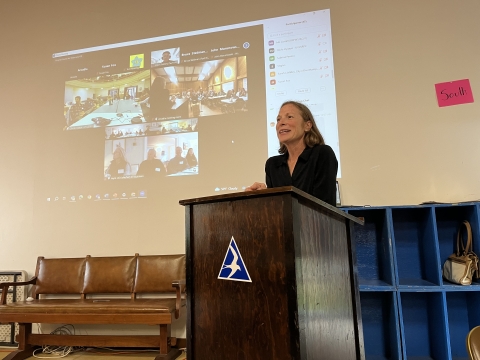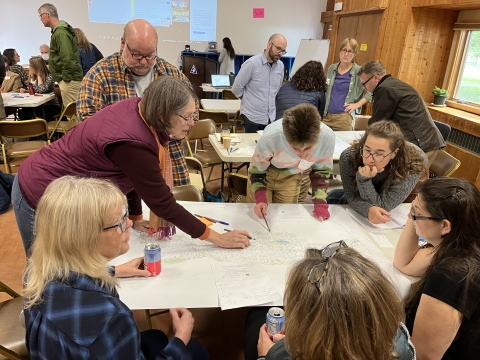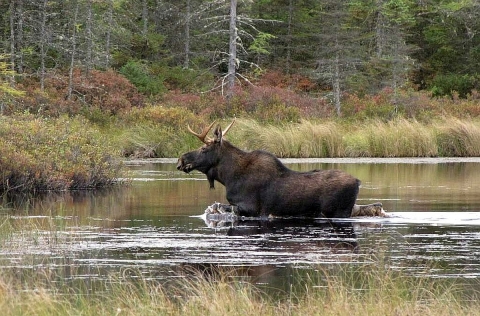Park at the U.S. Customs and Border Protection’s Port of Entry in Pittsburg, New Hampshire, then follow a rocky, steep-at-times trail crisscrossing in and out of Canada. You’ll reach a body of water ringed by a floating bog, tucked into a spruce-fir forest. While officially a lake, it looks more like a pond — small, calm and shallow. If you stood at its deepest point, your head would still be above the surface.
From this humble little lake spools a thread of water that becomes New England’s longest river. By the time it reaches the coast more than 400 miles south, it will surge into Long Island Sound as a 300-foot-wide channel.
How does this tranquil wetland become the mighty Connecticut River? Time and reinforcements. Over the course of its journey from the Canadian border to the sea — through New Hampshire, Vermont, Massachusetts and Connecticut — it's joined by 148 smaller waterways, or tributaries, that give it momentum and strength.
Joining forces
Conservation organizations working throughout the Connecticut River watershed have long taken a cue from the river, joining forces to grow their collective impact.
Now, partners are charting a strategic course, navigating new opportunities to collaborate.
In mid-October, the U.S. Fish and Wildlife Service and the Friends of the Silvio O. Conte National Fish and Wildlife Refuge hosted a Connecticut River Watershed Partner Meeting — in person and online — bringing together representatives from local, state and federal agencies, non-profit organizations, municipalities and regional planning commissions to discuss priorities and possibilities for conservation and stewardship across the basin.
“We come at conservation from different angles, but we have shared goals,” said Wendi Weber, Northeast Regional Director for the Service, in opening remarks at the Arcadia Wildlife Sanctuary in Easthampton, Massachusetts. “Today is about reinforcing what we have in common to create durable conservation outcomes for everyone who lives and works in this vital watershed.”
The meeting was both a showcase for what partners have accomplished together already and an invitation to think about future directions.
“Now is the time to think big about what we can achieve together for the watershed, and cultivate essential local, on-the-ground perspectives, to develop a shared and coordinated vision at all scales,” said Markelle Smith, director of the Friends of Conte and Conservation Partnerships at Mass Audubon.
Floating ideas
After short presentations highlighting examples of successes achieved through collaboration, participants broke into groups to discuss challenges they face in advancing their work, and potential solutions that can arise by aligning efforts.
Numerous ideas surfaced, including addressing barriers to participation for communities that have been excluded from conservation planning in the past, and focusing on complementary issues that may resonate with new constituents, like housing and historic preservation.
Before breaking for lunch, Jim Leavitt, director of the International Land Conservation Network at the Lincoln Institute of Land Policy, put participants’ work in context and emphasized its importance, even in challenging times. He noted that, in 1864, in the midst of the American Civil War, President Abraham Lincoln declared Yosemite Valley a public trust, setting a precedent in the U.S. — and the world — for conserving land for public benefit. Today, 20% of the global landmass is conserved.
“Remember that the outcomes of your work will last a long time,” he said.
In the afternoon, participants regrouped to study maps of the watershed and discuss areas where organizations might work together on projects that offer multiple benefits, from recreation to restoration to education.
Continuing momentum
Partners have been closely coordinating a watershed-wide approach to fisheries restoration, research and management since the 1960s — first through a technical committee, then through the congressionally authorized Connecticut River Atlantic Salmon Commission, and now as the Connecticut River Migratory Fish Restoration Cooperative.
In 1997, Congress established the Silvio O. Conte National Fish and Wildlife Refuge to protect the entire river system and the fish, wildlife and people who depend on it. It is the only national wildlife refuge national wildlife refuge
A national wildlife refuge is typically a contiguous area of land and water managed by the U.S. Fish and Wildlife Service for the conservation and, where appropriate, restoration of fish, wildlife and plant resources and their habitats for the benefit of present and future generations of Americans.
Learn more about national wildlife refuge to encompass an entire watershed.
Since 2005, the Friends of Conte — a partnership comprising more than 70 conservation, education, and recreation organizations across all the watershed states — has worked cooperatively with the Conte refuge and member organizations on land, water and trail projects that are the most timely and critical, under their shared goal of strengthening the health of the Connecticut River watershed and the communities that live in and are served by it.
The October meeting signaled a commitment to these long-standing relationships and a desire to expand existing networks with new organizations and ideas that will help sustain the Connecticut River watershed in the face of growing threats from land use and climate change climate change
Climate change includes both global warming driven by human-induced emissions of greenhouse gases and the resulting large-scale shifts in weather patterns. Though there have been previous periods of climatic change, since the mid-20th century humans have had an unprecedented impact on Earth's climate system and caused change on a global scale.
Learn more about climate change .
And it’s just the beginning.
“Our goal for future meetings is to really dive into local issues, with local organizations leading those discussions,” said Lisabeth Willey, science coordinator for the Service’s Science Applications program and co-organizer of the meeting. “We need to both support each other at the community level and coordinate at the watershed scale, to increase our collective capacity to take on projects that offer lasting benefits.”
Just like its tributaries, each partner, large or small, makes the river mightier.








